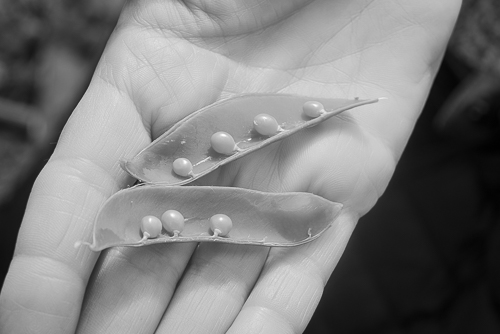Iker Villasana has been passionate about growing plants since he was a young boy when he tended his parents’ garden at their summer house in the seaside village of Ea. Later, he joined the driving school of his parents, but some years ago he bought the farm Baserri Biortzatxu, intending to be a full-time farmer. Now, he has a typical Basque brick house in the countryside and there are fields of eggplants, onions together with rows of edible plants labelled italiano, which is a pepper from Italy, piper cristal which is a local pepper variety from Navarra and La Rioja and piper cuerno toro, which is a red pepper. Besides, there was an enclosure with about 20 free-ranging hens next to the house.
Having met Iker at his house, we followed him to his greenhouse in the village of Fruiz where he and a partner are growing a wide variety of herbs, fruits and vegetables.
His philosophy is to grow plants ranging, from the autochthonous to the exotic, which others don’t, willingly trying unusual plants like the toothache plant, which is also known as electric flower. Inside the greenhouse, we picked some leaves of this plant and after chewing a little, it felt like the mouth was slightly numb.
We also noticed his white strawberries, which according to this website, white strawberries lack the ability to turn red even when they are mature.
Another uncommon variety is huazontle, a Mexican vegetable which was a staple crop in Central and North America in pre-Columbian times.
He has also resurrected zucchini flowers for eating, which feels almost like a kind of déjà-vu experience for me since I have harvested zucchini flowers at Ødeverp farm this summer. Pouring olive oil on them and eating them was delicious, but it seems like the Spanish prefer cooking them. Interestingly, Iker harvests zucchini flowers at nightfall when the flowers are closed.
The first Sunday of each month he sells his products at an outdoor market in Arrieta where the mayor of Arrieta regularly tells him that his grandmother used to cook zucchini flowers, but it had since been forgotten by his family.
Iker is also growing tear peas, which are also known as green caviar and, early in the morning in order to avoid strong sunlight, he feels them by his hands to sense if they are mature and ready to be picked. The tear pea is expensive because of its unpredictable and short harvest, the intensive labour it requires, and the need to transport it quickly from greenhouse to kitchen. For those who want to know more about tear peas, The Tear Pea, Caviar From the Earth’s Womb is worth reading.
In addition to the tear peas, he harvests “baby” versions of other vegetables, including undersized pumpkins, carrots, and six varieties of eggplants, originally from countries like Turkey, Italy and Japan.
For the first two years, he sold as many as 20 varieties of pumpkins and other produce at specialty food markets and local fairs,
Besides, Iker leads a double life as both a farm and a gatherer, crossing the woods in search of wild treasures such as sorrel, clover, pine leaves or flowers of acacia and elderberry.
Outside the greenhouse, there was a small plantation of mini kiwi fruit or kiwi berries, which had been planted a short time ago. When the fruits are mature, they will be the size of strawberries and their skin can be eaten contrary to kiwifruit, whose skin has to be removed.
Some years ago, Iker met Josean Alija, chef at the Guggenheim restaurant Nerua. Although it felt like we were far away from towns when we visited Iker, Bilbao is only about 23 kilometeres away and he delivers fresh produce to the restaurant regularly.

